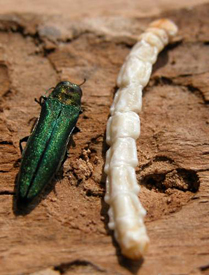LITTLE CURRENT—At last Thursday’s Northeast Town community services/public works committee meeting, the Canadian Food Inspection Agency (CFIA) officially announced the finding of the emerald ash borer (EAB) on Manitoulin.
The invasive species has devastated southern Ontario, infesting all varieties of ash trees and slowly killing the trees similar to the Dutch elm disease outbreak of the 1960s.
Julia Ruhl, program officer for the Plan Protection division of the CFIA and Margaret Mais, regional program officer, spoke to the Northeast Town committee about the EAB, explaining how the beetle was discovered on the Island, the history of the species in Canada, how the government is dealing with the infestation and what the EAB will mean for Manitoulin.
The CFIA representatives explained that the EAB was confirmed on Manitoulin in late October. After further inquiry from The Expositor, the paper learned that the insect was discovered in a trap on Manitoulin in July of this year, but was not confirmed until October.
According to Ms. Ruhl, a suspected EAB was captured in one of the six traps on Manitoulin. “We have over 700 traps deployed across Canada,” explained Ms. Ruhl. “We place them in high risk sites such as campsites and golf courses. The EAB on Manitoulin was from a trap located on private land by Highways 6, near Sheguiandah.”
When asked why it took so long to notify the municipality and public of the presence of the EAB on Manitoulin Ms. Ruhl replied that that it takes time for a proper identification.
In the CFIA’s presentation, Ms. Ruhl and Ms. Mais told the Northeast Town that the EAB is Native to eastern Asia and was first discovered in Canada in Windsor in July of 2002.
“It is believed to have been introduced into North America via wood packaging materials,” explained Ms. Ruhl. “It is now considered a quarantine pest in Canada and the United States.”
With a 99.9 percent kill rate, Ms. Ruhl warned municipal officials of the severity of EAB on Manitoulin.
She explained that this development now means that Manitoulin is an EAB quarantine zone, meaning that individuals will no longer be able to export or transport firewood off of Manitoulin unless part of the CFIA’s compliance program.
“There are 35 mills operated throughout Ontario registered with the EAB approved facility compliance program,” said Ms. Ruhl.
At present, there is no any cures against the infestation of the EAB, but Ms. Ruhl said that the CFIA is approaching the issue by working to slow down the infestation through surveillance, regulation, compliance/enforcement, and communication/public outreach.
Ms. Ruhl presented the CFIA EAB 2011 Survey Plan, which outlines a two-component system: an ash decline survey/visual survey for signs/symptoms for the EAB and traps, such as the one of Manitoulin that captured an EAB.
Ms. Ruhl and Ms. Mais explained that the CFIA conducts inspection on high-risk areas such as campgrounds for violations and vehicles transporting firewood. “Individuals who violate the Plant Protection Act can be penalized up to $250,000 and/or to imprisonment for a term not exceeding two years,” states the CFIA’s presentation. “Agriculture and Agri-Food Administrative Monetary Penalties Act: For those who violate the Plant Protection Act, immediate penalties of up to $15,000 may be issued.”
The two presenters also explained to council that communicating the presence of the EAB on Manitoulin and educating town staff through CFIA programs is an important step in preventing the spread of the EAB to other regions.
Mayor Joe Chapman inquired to the placement of a sign at the swing bridge, notifying visitors and residents of the EAB and the quarantine.
Ms. Ruhl explained that the CFIA was not installing signs at the same rate they were when the EAB original began infesting Canada, due to the fact that the infestation is so wide spread now and that many municipalities are putting up their own signs.
“It is very unfortunate that due to the actions of someone who was too lazy or too cheep to buy local firewood, our ash trees are now sentenced to death,” stated Mayor Chapman. “I think that people just need to know and that once they do they will be compliant.”
The mayor added that he did not feel that it was reasonable for the government to put the burden on the municipality to put up a sign.
“Please tell your supervisors that we are different than Sault Ste. Marie or Montreal,” said Mayor Chapman. “Be aware that we don’t have the same resources.”
Ms. Ruhl and Ms. Mais replied that they would speak to the supervisors and hopefully work with the municipality to install a sign coming onto Manitoulin.
During the conclusion of the CFIA’s slide show, Ms. Ruhl reviewed what the municipality can expect moving forward since the infection, such as an increase in tree removal and maintenance. She recommended the municipality should conduct an “Ash inventory to assess economic and environmental impacts of the community, budget planning and allocation, training personnel to recognize sign and symptoms, identifying ‘hot spots’ and extent of infestation within community,” and the possibility of vaccinating municipal ash trees with Tree-Azin, a bi-annual treatment which protects the trees from the EAB.
“Thank you for coming here and delivering this presentation,” said the mayor to Ms. Ruhl and Ms. Mais. “It’s great to have started the process.”
The mayor and council began discussion as to the effects that the EAB will have on Manitoulin, but have not yet begun the process of developing a plan of action for the Northeast Town.
